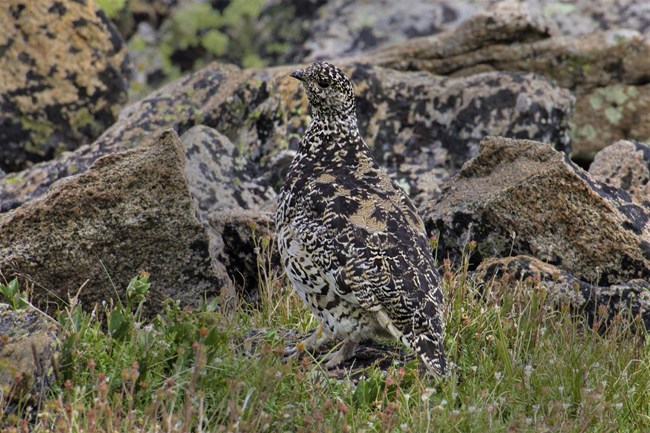Last updated: July 29, 2020
Article
White-tailed Ptarmigan: Rocky’s Elusive Alpine Dweller

NPS/A Schonlau
The reason why I didn’t see them at first is because they are expert at camouflaging into the landscape. They have grayish-brown mottled plumage in the summer and white plumage in the winter, which means they spends eight months of the year molting feathers! That is big energy output that they need to prepare for in the summer months. When hiking on trails in the tundra, these birds, which are the smallest of the grouse in North America, blend in so well that you may walk right by them, nestled in the rocks for protection, or foraging for plant material like stems, leaves, flowers and seeds.

NPS/K Daugherty

NPS
The Trail Ridge Road ptarmigan has had a tough go of it – between the mid-1970s and 2000, the population had declined by 66%. Ongoing studies are investigating changes in the seasonal timing (also called "phenology") of breeding and habitat use to learn what contributes to the decline. Spring snow depth and melt times can alter reproduction and laying of eggs, especially if the process is mistimed relative when food emerges (Wann 2017). If warming springs are reducing snowpack earlier in the year, yet ptarmigan are remaining white and haven’t started their molting phase, their survival may be affected due to predation (Wann et al. 2016). These alpine predators are coyotes, foxes, and raptors.
Alpine willows (Salix planifolia and S. brachycarpa) are important habitat indicators. Studies are looking at browsing levels on the willow by ungulates such as elk (Cervus canadensis) or moose (Alces alces). These large ungulates spend their summers in the high country to escape the heat of the lower valleys below, and willow is a primary food source for both moose and ptarmigan. Elk like to nibble on it too. Ptarmigan also rely on alpine willows for nest site selection and hens at RMNP are more likely to nest in areas with more willow cover. Changing habitat conditions and food competition, specifically the availability of alpine willow, limit suitable nesting habitat for ptarmigan, and could be additional factors contributing to population decline.
The southern white-tailed ptarmigan, as well as the Mt. Rainier white-tailed ptarmigan (L. l. rainierensis), are both "Under Review" for potential protection under the U.S. Endangered Species Act. They were petitioned to be listed as Threatened with Critical Habitat in 2012 by the U.S. Fish and Wildlife Service, and in March 2020, work began on a Species Status Assessment (SSA) to help determine if such protection is needed.
When wandering on the high alpine trails this summer, keep your eye out for these special birds, listen for their calls in the rocks, and you may just get to have your own special moment surrounded by Ptarmigan too!
To learn what the males and females sound like, along with their respective distress calls, use this resource. You can also search for any other bird species and learn their calls too! https://www.allaboutbirds.org/guide/White-tailed_Ptarmigan/sounds
The southern white-tailed ptarmigan, as well as the Mt. Rainier white-tailed ptarmigan (L. l. rainierensis), are both "Under Review" for potential protection under the U.S. Endangered Species Act. They were petitioned to be listed as Threatened with Critical Habitat in 2012 by the U.S. Fish and Wildlife Service, and in March 2020, work began on a Species Status Assessment (SSA) to help determine if such protection is needed.
When wandering on the high alpine trails this summer, keep your eye out for these special birds, listen for their calls in the rocks, and you may just get to have your own special moment surrounded by Ptarmigan too!
To learn what the males and females sound like, along with their respective distress calls, use this resource. You can also search for any other bird species and learn their calls too! https://www.allaboutbirds.org/guide/White-tailed_Ptarmigan/sounds
References:
King S. and C. Turner. 2018. Resource Brief: Southern White-tailed Ptarmigan. Continental Divide Research Learning Center, Rocky Mountain National Park. https://irma.nps.gov/DataStore/Reference/Profile/2252846
Wann, G.T. 2017. Reproductive Ecology and Population Viability of Alpine Endemic Ptarmigan Populations in Colorado. Colorado State University, Dissertation.
Wann. G.T, C.L. Aldridge, and C.E. Braun. 2016. Effects of Seasonal Weather on Breeding Phenology and Reproductive Success of Alpine Ptarmigan in Colorado. PLoS ONE 11(7): e0158913. doi:10.1371/journal.pone.0158913
Yuhas. D. 2014. Ptarmigan May Be Tops in Adapting to Winter Weather. National Audubon Society. https://www.audubon.org/news/ptarmigan-may-be-tops-adapting-winter-weather
U.S. Fish & Wildlife Service. ECOS Environmental Conservation Online System. https://ecos.fws.gov/ecp0/profile/speciesProfile?spcode=B0H8
King S. and C. Turner. 2018. Resource Brief: Southern White-tailed Ptarmigan. Continental Divide Research Learning Center, Rocky Mountain National Park. https://irma.nps.gov/DataStore/Reference/Profile/2252846
Wann, G.T. 2017. Reproductive Ecology and Population Viability of Alpine Endemic Ptarmigan Populations in Colorado. Colorado State University, Dissertation.
Wann. G.T, C.L. Aldridge, and C.E. Braun. 2016. Effects of Seasonal Weather on Breeding Phenology and Reproductive Success of Alpine Ptarmigan in Colorado. PLoS ONE 11(7): e0158913. doi:10.1371/journal.pone.0158913
Yuhas. D. 2014. Ptarmigan May Be Tops in Adapting to Winter Weather. National Audubon Society. https://www.audubon.org/news/ptarmigan-may-be-tops-adapting-winter-weather
U.S. Fish & Wildlife Service. ECOS Environmental Conservation Online System. https://ecos.fws.gov/ecp0/profile/speciesProfile?spcode=B0H8
Camille Thorson, Learning Specialist
Continental Divide Research Learning Center
July 2020
